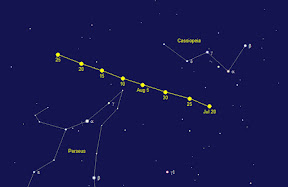One of summer's most anticipated events in the night sky is the annual return of the Perseid Meteor showers. Through the ages, the comet, known as 109P/Swift-Tuttle has spread its falling ice and rock debris as it has passed through the solar system. As the debris streams from the comet, it forms the comet's visible tail. The solid pieces of debris are called meteoroids.
The meteoroids spread out along the entire orbit of the comet to form a meteoroid stream. As the Earth orbits the Sun, its orbit sometimes takes us through a meteoroid stream and a meteor shower ensues. The meteoroids encounter Earth's atmosphere at a very high speed. As the meteoroids streak through the atmosphere, friction causes the particles to burn and incandesce, forming meteors. When the meteoroid stream is particularly dense, we occasionally see a spectacular meteor storm, bright streaks and even fireballs.
The meteoroids spread out along the entire orbit of the comet to form a meteoroid stream. As the Earth orbits the Sun, its orbit sometimes takes us through a meteoroid stream and a meteor shower ensues. The meteoroids encounter Earth's atmosphere at a very high speed. As the meteoroids streak through the atmosphere, friction causes the particles to burn and incandesce, forming meteors. When the meteoroid stream is particularly dense, we occasionally see a spectacular meteor storm, bright streaks and even fireballs.
When the Earth sweeps through its band every year from late July to late August, the dust burns up from friction with the upper atmosphere and creates silent streaks that slice across our night sky. Because Swift-Tuttles's meteors fly out of the constellation Perseus, they are called "Perseids."
The Perseids are one of the oldest meteor showers that mankind has records for. The earliest observations were made by the Chinese in 36 A.D. when the Perseids peaked, not in August, as they do today, but in July. Because the path of the shower in highly inclined to the ecliptic (the pane in which the Earth and all of the other planets orbit the Sun), the Perseids have no been affected by the disturbing gravitational influences f our major planets. As a result, they are a reliable meteor shower. From 714 A.D. until the present year, the Perseids have been recorded every year.
As the night unfolds, Perseus will climb higher and the meteor rate will increase many-fold. Most Perseids are bright, yellow meteors, with speeds around 36 miles per second. Expect to see several fireballs, which frequently leave trails of smoke and many times even explode midway! The show begins Sunday, August 12 at 9 pm (your local time) and really gets going around 2 a.m. on the 13th. The crescendo comes before dawn when rates could exceed a meteor a minute.
To truly enjoy the spectacle, get away from city lights, into a wide open viewing space. The conditions this year could not be more perfect. It is the beginning of a new moon, so the night sky, itself, will be dimmed, except for the meteor showers.
Silver Creek Falls State Park (near Salem, Oregon) hosts a star party, every summer, in honor of the Perseids. The local astronomy club Night Sky 45 sets up telescopes ranging in size from 6" to 22". Entire families camp out, paying only a $3 park fee for parking vehicles and experienced club members direct the scopes to specific sky points. Participants bring their own telescopes or binoculars, as well and it creates a wonderful educational evening, as well as a lot of fun!

shown here:
the projected path of the comet between the constellations, Perseus and Cassiopeia

No comments:
Post a Comment